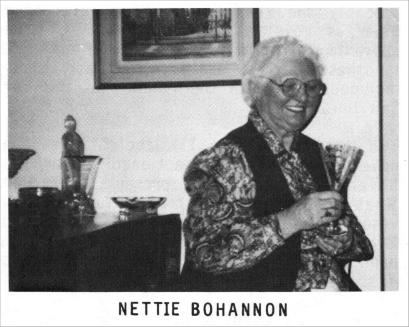National Cambridge Collectors, Inc.
A non-profit 501(c)(3) organization.

Worker of the Month: Nettie Bohannon
by Jeff Ross - Issue #230 - June 1992
Our April Worker of the Month is Nettie Bohannon. Nettie worked in the Paint Shop of the Etching Department for 16 years. Her job entailed painting the wax onto the glass in preparation for the acid dip.
 Nettie described her first day of work at Cambridge Glass as a bitterly cold
morning in 1933. Like many of the workers who lived south of Cambridge, Nettie
relied on the bus to get her to the plant. She recalled that she caught the
bus at 5:30am every morning in order to be at work by the 6:45am starting time.
Nettie described her first day of work at Cambridge Glass as a bitterly cold
morning in 1933. Like many of the workers who lived south of Cambridge, Nettie
relied on the bus to get her to the plant. She recalled that she caught the
bus at 5:30am every morning in order to be at work by the 6:45am starting time.
She was hired by Mr. Roy Pritchard, head of the Decorating Department. She stated that it took her about a month to get comfortable with working with the wax, due to the varying etching patterns and the different consistencies of the wax. Larger pieces required the wax to be thick, while other smaller items were painted with thinner wax. The area to be covered was the determining factor.
Nettie described the Paint Shop as a series of tables where the women would sit across from one another to work. Each woman had heat controls to regulate the temperature and thickness of the wax. Each worker was provided with a basic 1" brush, but any other brushes needed were the responsibility of the individual worker. Nettie recalled that it took six to eight brushes of various sizes to do the job.
Most of the ware that she worked with was crystal. Occasionally she helped with sample pieces to be used at trade shows, etc. Rose Point was the easiest pattern to cover, according to Nettie. She mentioned that she could cover about 20 Rose Point stems in an hour. Elaine and Candlelight were the most difficult. Covering the Caprice pattern for the Alpine treatment was also a tedious task, according to Nettie. She recalled that one woman in the department did nothing but Alpine.
Although Nettie enjoyed her work, she said that most days she spent her 40 minute lunch hour at the employee cafeteria to "get away" from the factory. The work was tedious and she thought she did better when she got away from it for a while. Nettie stated that Mr. Pritchard ws "A-1" to work for, as were the other supervisors.
There were only two regrets that Nettie expressed. The first ws that she didn't buy more glass when she worked at the factory. But, as she said, money was scarce and noone realized how valuable the ware woudl become. At the time, it was a job and a livelihood.
The second regret was that in all of the time that she worked at the plant, she never did tour the entire factory. At the time, she and others thought that there would always be a Cambridge Glass plant to tour.
We appreciate the time that Nettie took to be with us in April. Her comments and experiences were a valuable addition to our living library of former workers.